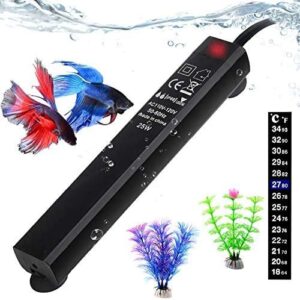Hey fish lovers! Are you ready to dive deep into the world of aquarium heaters? Maintaining an ideal water temperature for your aquatic friends is essential, yet choosing one can seem like trying to navigate an underwater reef blindfolded. Don’t fret though; this guide is here as your scuba gear. We will explore different types of heaters and their as well as advantages and disadvantages before helping you select your ideal heaters! Submersible Heaters: The Workhorses of the Tank
Submersible Heaters: The Workhorses of the Tank
Submersible heatersare the most popular choice for aquariums. These versatile champions come in various wattages and sizes, making them suitable for tanks of all shapes and volumes.
Pros:
- Efficiency: Submersible heaters directly heat the water, ensuring efficient temperature regulation.
- Versatility: Available in a wide range of wattages and sizes, they can cater to any tank size and heating needs.
- Placement: They can be positioned strategically for optimal water circulation and temperature distribution.
- Durability: Many submersible heaters are made from shatter-resistant quartz glass or stainless steel, promoting longevity.
- Visibility: Some models come with LED indicators that display the current temperature, allowing for easy monitoring.
Cons:
- Aesthetics: Submersible heaters can be visually intrusive in the tank, potentially disrupting the aquascape.
- Space Considerations: Larger tanks might require multiple submersible heaters to maintain proper temperature, impacting aesthetics and tank space.
Hang-On Heaters: Saving Space for Smaller Tanks.
Hang-on heaters are ideal for compact aquariums. They attach to the rim of the tank, partially submerged in the water.
Pros:
- Space-Saving Design: Perfect for smaller tanks where interior space is limited.
- Affordability: Hang-on heaters are generally more budget-friendly compared to some submersible models.
- Easy Installation: They are simple to set up and require minimal maintenance.
Cons:
- Limited Wattage: Typically have lower wattages, making them unsuitable for larger tanks.
- Uneven Heating: May struggle to distribute heat evenly throughout the tank, especially in larger aquariums.
- Vulnerability: Exposed to fish potentially bumping or damaging them.
- Aesthetics: Similar to submersible heaters, they can disrupt the visual appeal of the tank.
In-Sump Heaters: The Hidden Heaters for Large Systems.
In-sump heaters are a hidden gem for large aquariums and sump setups. They reside within the sump tank, away from the main display, offering a discreet heating solution.
Pros:
- Unobtrusive: Hidden from view in the sump, maintaining the aesthetics of the display tank.
- Powerful Heating: Designed for larger water volumes, ensuring efficient temperature control in big aquariums.
- Safety: Separation from the main display minimizes the risk of accidental contact with fish.
Cons:
- Complexity: Requires a sump setup, adding a layer of complexity to the system.
- Cost: Generally more expensive compared to other heater types.
- Maintenance: Cleaning and maintenance might require additional effort due to the sump placement.
Undergravel Heaters (UGHs):A Warmer Substrate Option.
Undergravel heaters (UGHs) are placed beneath the substrate, warming the water from the bottom up.
Pros:
- Natural Heating: Mimics the natural heating patterns of some aquatic environments.
- Promotes Plant Growth: Warmth from below can benefit bottom-feeding plants.
- Frees Up Tank Space: No bulky heaters intruding on the display area.
Cons:
- Maintenance Challenges: UGHs necessitate disturbing the substrate during cleaning, potentially disrupting the tank’s biological balance.
- Uneven Heating: May struggle to heat the upper water column effectively, leading to temperature fluctuations.
- Risk of Substrate Issues: Improper setup or substrate choice can lead to hotspots, dead zones, and potential ammonia spikes.
Choosing the Right Heater for Your Aquarium
Now that you’re familiar with the various types of aquarium heaters, let’s navigate the selection process:
- Tank Size: The most crucial factor! Choose a heater with enough wattage to maintain the desired temperature for your specific tank volume.
- Climate: Consider your ambient room temperature. Colder climates might require a higher-wattage heater.
- Fish Species: Different fish species have varying temperature preferences. Research the ideal temperature range for your specific fish and choose a heater that can comfortably maintain it.
- Tank Setup: Planted tanks might require slightly higher temperatures to support plant growth. Consider this additional heating demand.
- Budget: Aquarium heaters range in price depending on brand, features, and technology. Determine your budget and choose an option that offers the best value for your needs.
Bonus Considerations:
- Auto-Shutoff: Look for heaters with an automatic shut-off feature that prevents overheating.
- Adjustable Thermostat: Heaters with adjustable thermostats allow for precise temperature control.
- Material: Submersible heaters made from shatter-resistant quartz glass or stainless steel offer better durability.
- Safety Features: Some heaters come with features like indicator lights or alarms to warn of malfunctions or temperature fluctuations.
Fish Desire: Your Partner in Maintaining a Thriving Ecosystem
Remember, a stable temperature is vital for the health and well-being of your fish. By selecting the right type of heater and maintaining it properly, you can create a comfortable and thriving environment for your finned friends.
At Fish Desire, we are passionate about helping you create a flourishing aquarium. We offer a wide selection of aquarium heaters from trusted brands, ensuring you have the tools you need to keep your aquatic paradise warm and healthy. For further information or personalized recommendations on choosing the ideal heater for your setup, feel free to contact our friendly staff.
Additional Tips from Fish Desire:
- Double Up for Redundancy: For critical setups, consider using two heaters of slightly lower wattage instead of one high-wattage heater. This provides redundancy and prevents catastrophic temperature drops if one heater malfunctions.
- Monitor Temperature Regularly: Invest in a reliable thermometer to monitor your tank’s temperature and ensure the heater is functioning properly.
- Regular Maintenance: Clean your heater regularly according to the manufacturer’s instructions to prevent malfunctions and ensure optimal performance.
By following these tips and choosing the right heater for your aquarium, you can ensure your fish thrive in a warm and comfortable environment. Let Fish Desire be your partner in creating a thriving underwater world!
Happy Fishkeeping!




